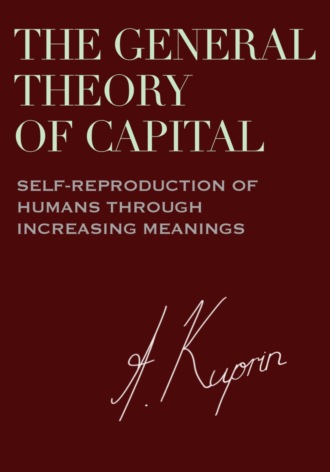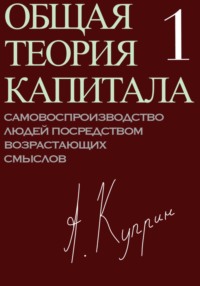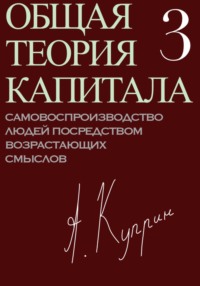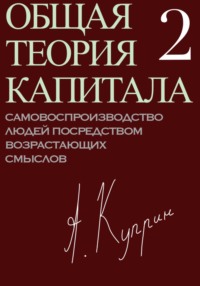
Полная версия
The General Theory of Capital: Self-Reproduction of Humans Through Increasing Meanings
“Man is characterized by a free, i.e. consciously performed action in accordance with the universal, general goal of humanity. The ideal is this idea of the ultimate perfection of humanity. It thus includes the awareness that man is the end of his own activity in itself and in no way a means for someone or for something, be it God or a thing in itself. According to Kant, the ideal as a state of achieved perfection of the humanity, which we imagine today, is characterized by the complete overcoming of the contradictions between the individual and society, i.e. between the individuals who make up society (humanity)” (Ilyenkov 2019-, vol. 6, pp. 56-57).
Each moment in the evolution of culture-society is characterized by its own ideal, its own norms and its own choices that people make. By social necessity we understand a counterfactual result of social choice, of the activities and actions of people carried out within the framework of an imagined ideal socio-cultural order. By individual necessity we understand the case when a person (or a small group) makes a choice not only for himself but also for others. Justice is the degree of correspondence between social and individual choice, between social and individual necessity. Trust, justice and reciprocity are key elements of sociality that allow culture-society to reproduce itself. As Karl Polanyi noted, reciprocity and reputation, centralization and redistribution of goods were the basis of the socio-cultural order of early traditional communities: “Reciprocity and redistribution are able to ensure the working of an economic system without the help of written records and elaborate administration” (Polanyi 2001, p. 51).
The socio-cultural order is not a totality or a whole in relation to which individuals act as its parts. However, there are domains of order—for example, the state and other types of political and economic organization—that tend to become a totality. By combining economic and political power, the state becomes a self-sufficient meaning. By separating individuals from humanity and standing between them, states and social categories make justice and trust dependent on their functioning.
Active power and freedom
There are generally two approaches to the application of the term “culture.” In the first case, culture is defined as everything that is opposed to “nature,” and it is precisely in this sense that we have used this term so far. In the second case, culture is defined as that which goes beyond the boundaries of economics and politics. We will call the first, broader meaning “culture” and the second, narrower meaning “culture*.” The division of culture into politics, economics and culture* is itself the result of the evolution of meanings, their division, addition and multiplication.
Our broader understanding of culture differs from the approach that is characteristic of many representatives of the social sciences. For example, Daron Acemoglu and James Robinson reduce culture to culture*, that is, ideas, beliefs, values, morals:
“The culture hypothesis, just like the geography hypothesis, has a distinguished lineage, going back at least to the great German sociologist Max Weber, who argued that the Protestant Reformation and the Protestant ethic it spurred played a key role in facilitating the rise of modern industrial society in Western Europe. The culture hypothesis no longer relies solely on religion, but stresses other types of beliefs, values, and ethics as well” (Acemoglu and Robinson 2012, p. 56-57).
Reducing culture to culture* might make sense if we assume that culture* is in some way a minimal description of culture as a whole. By culture* we mean relationships between people with respect to thinking. Thinking is not limited to working with symbols and concepts; at its core, thinking is a deeply emotional and thus psychophysical process; this is evident, for example, in religion, art and play. Nor is thinking limited to the processes of the brain; it is the activity of the entire human body, insofar as this activity is aimed at human psychology, at the mental world. Culture* is, if you will, a choice of thinking.
Here we need to clarify a difference between an individual and a personality. Personality is not the same as an individual: individuals form the population, personalities form the culture-society. Personality is “a special quality that an individual acquires in society” (Leontiev 1983, vol. 1, p. 385).
“Personality is not a genotypically determined integrity: one is not born a person, one becomes a person. Therefore, we do not speak of the personality of a newborn or the personality of an infant, although personality traits appear no less clearly in the early stages of ontogenesis than in later age stages” (Leontiev 1983, vol. 2, p. 196).
We wrote above that meaning as an activity creates culture-society. The part of the aggregate activity that is performed by an individual shapes his personality. The reproduction of culture-society in the population becomes the reproduction of personality in the individual:
“…The real basis of an individual’s personality lies not in the genetic programs inherent in him, not in the depths of his natural makings and inclinations, and not even in the skills, knowledge and abilities he has acquired, including professional ones, but in the system of activities implemented through his knowledge and skills” (Leontiev 1983, vol. 2, p. 202).
We could probably say that personality is active knowledge. “Knowledge is action, because the correction of knowledge entails the renovation of ourselves” (Frisina 2002, p. 76). From this point of view, the increase of the subject—both of a culture-society and of a personality—consists in the increasing complexity of knowledge, its division, addition and multiplication. When Hayek introduced the concept of the “division of knowledge,” he wanted to go beyond the “division of labor” as a collection of existing activities. The division of knowledge, according to Hayek, is the set of all possible activities in a given state of the culture-society, that is, a set of counterfacts:
“Knowledge in this sense is more than what is usually described as skill, and the division of knowledge of which we here speak more than is meant by the division of labor. To put it shortly, ‘skill’ refers only to the knowledge of which a person makes use in his trade, while the further knowledge about which we must know something in order to be able to say anything about the processes in society is the knowledge of alternative possibilities of action of which he makes no direct use. It may be added that knowledge, in the sense in which the term is here used, is identical with foresight only in the sense in which all knowledge is capacity to predict” (Hayek 1988-2022, vol. 15, p. 73).
However, the set of possible activities is not determined only by knowledge. Personality is not reduced to cognitive functions or technologies. The principle of least action is not about minimizing technology, but about minimizing effort in general. The least technological action can result in social and psychological losses and costs that more than outweigh any saving in material effort—this applies, for example, to morality, reputation and criminal law (cf. Polanyi 2001, p. 49). Many actions are not based on knowledge, but on unfounded and false ideas, on creative impulses, prejudices and affects. “Our moral/aesthetic frameworks are complicated constructions that combine broad cultural inheritances with dense mixtures of abstract reasoning and the immediacies of concrete experience” (Frisina 2002, p. 14). Moral/aesthetic frameworks influence consciousness and personality no less than cognitive ones.
The activities of an individual form an active power within him, namely his personality and identity. If personality sets individuals apart, then identity embeds them in a society by specifying how they should behave depending on their position within the social context (Akerlof and Cranton 2010, p. 10). George Akerlof and Rachel Cranton identify three parts of identity: 1) social categories, 2) norms and ideals, 3) gains and losses (identity utility). People choose their identity in both the long and short term; this choice is not necessarily conscious. Social categories are social roles and groups with which individuals identify; norms and ideals define right and wrong; gains and losses are the ability to conform to norms and ideals (a particular social role/position) and the resulting benefits or harms to the individual (Akerlof and Cranton 2011, pp. 17-19).
However, when economists try to extend the theory of utility to a real person and his active power, the limitations of neoclassical theory become clear. Akerlof and Cranton themselves show that identity cannot be reduced to “gains and losses in utility.” In his life, a person is driven not only by the needs of existence, ordered by utilitarian preferences. A person is also driven by norms and ideals, by needs for communication and self-expression. Utility, norms and ideals are not ordered among themselves—they often conflict. The principle of least action implies that, along with the requirements of utility, a person also takes into account the norms of justice and the ideals of freedom. Freedom is the ability of a person to choose between activities. The meaning of life consists of those meanings that a person has chosen for himself from culture-society. In his activity, a person is guided not by the function of utility, but by the function of meaning, in which utility is only one of the arguments. Besides, unlike neoclassical “utility,” which has no historical dimension, meaning evolves. Neoclassical utility can be “maximized” here and now, and increasing meaning may require a process of personal and socio-cultural evolution.
Simple examples of a person’s actions against his own benefit are actions committed for religious or ethical reasons. When a person enters the realm of the possible thanks to counterfacts, the formation of personality leads him to the edge of his everyday life and to the premonition of death. The fear of death itself is the result of the evolution of meanings: “Knowledge of death, of the inconceivable possibility that the experiences of life will end, is a datum that only symbolic representation can impart” (Deacon 1997, p. 436). At the edge of his personal existence, man comes to the supernatural and to religion. Religion is one of the most motivating domains of meaning in the history of culture.
Morality is another domain of meaning that we have inherited from traditional society. It is the result of consistent learning over many generations and is therefore a practice that lies between instinct and reason. It is closely linked to immediate emotional, affective reactions:
“Once we view morals not as innate instincts but as learnt traditions, their relation to what we ordinarily call feelings, emotions or sentiments raises various interesting questions. For instance, although learnt, morals do not necessarily always operate as explicit rules, but may manifest themselves, as do true instincts, as vague disinclinations to, or distastes for, certain kinds of action. Often they tell us how to choose among, or to avoid, inborn instinctual drives” (Hayek 1988-2022, vol. 1, p. 13).
Darwin’s theory of the evolutionary origin of emotions led Herbert Spencer and some of his followers to conclude that people would become less emotional in the future—it is the so-called “rudimentary” theory of emotions. James Scott notes that as domestication progressed in both humans and animals, their limbic systems, responsible for producing hormones and responding to threats and other stimuli, shrank and they became less emotional. The creation of the domus as a cultural niche meant that cultural selection factors—the ability to get along with one’s neighbors in the house—began to play a larger role compared to factors of the natural environment (Scott 2017, pp. 81-86). Although we can probably speak of the evolution of emotions, emotions were and remain the oldest and most fundamental element of thinking.
Tradition itself is not only the result of learning and cultural selection, but also of choice based on both emotion and reason. In the course of its evolution, tradition gradually but surely crossed the line between mere reactive behavior and meaningful action. It has changed from an animal to a human tradition and has become an accumulation of religious and moral practices, a value-rational action “determined by a conscious belief in the value for its own sake of some ethical, aesthetic, religious, or other form of behavior, independently of its prospects of success” (Weber 1978, pp. 24-25).
The foraging economy consisted of activities arising from natural necessity, with the rhythm and content of human life determined by the rhythm and content of natural processes. An individual essentially could not choose and had no choice within this fixed set of activities. The transition to agriculture led to two major changes. (1) The multiplicity of activities increased: an individual could choose—at least potentially—who he wanted to be and what activities he wanted to perform. (2) The technologies of foraging were relatively simple and each member of the tribe learned them and could reproduce them with some degree of success. The technologies of an agrarian society were more complex: the peasant, the artisan and the warrior did not learn the technologies that the other possessed and thus could not reproduce them. At the same time, an increase in the traditional order meant that most people were at the mercy of another human: natural uncertainty was supplemented and replaced by socio-cultural uncertainty generated by the state and social categories:
“It would be almost impossible to exaggerate the centrality of bondage, in one form or another, in the development of the state until very recently. As Adam Hochschild observed, as late as 1800 roughly three-quarters of the world’s population could be said to be living in bondage. In Southeast Asia all early states were slave states and slaving states; the most valuable cargo of Malay traders in insular Southeast Asia were, until the late nineteenth century, slaves. Old people among the so-called aboriginal people (orang asli) of the Malay Peninsula and hill peoples in northern Thailand can recall their parents’ and grandparents’ stories about much-dreaded slave raids. Provided that we keep in mind the various forms bondage can take over time, one is tempted to assert: ‘No slavery, no state’” (Scott 2017, pp. 155-156).
The transition from foraging to farming, paradoxically, accelerated the growth of meanings and at the same time slowed it down. An increase in activities meant an acceleration, an increase in order—a slowing down of cultural evolution. The entire history of traditional society is a very slow and gradual increase in the proportion of people who are subjects of choice. Why was this process so slow? Perhaps because personal freedom depends on the progress of personality, that is, consciousness. It is personal freedom, the ability to choose for oneself, that is the main condition for the growth of meanings and for the acceleration of this growth:
“Locke says that ‘Freedom of Men under Government’ means ‘not to be subject to the inconstant, uncertain, unknown, Arbitrary Will of another man.’ Uncertainty in general and man’s inconstancy in particular therefore become the arch-enemy that needs to be exorcised” (Hirschman 1977, p. 53).
We would not reduce the complication of thinking and consciousness to the division and addition of knowledge, personality or identity. We are talking about the division and addition of active power as a whole. The division, addition and multiplication of active power means an increase in the complexity of the subject, both the individual human being and the culture-society as a whole. An increase in the number of counterfacts with which a culture-society or an individual operates means an increase in the entropy of the source of meanings, i.e. an increase in the minimal subject.
The division of active power develops along with the division of activity and the division of order that we discussed earlier. Historically, the division, addition and multiplication of meanings leads to a gradual and eventually major divergence between the complexity of the individual and the complexity of the culture-society. An individual takes part in only some of the activities produced by culture-society and operates within only a small part of the socio-cultural order. As a result of this divergence in the growth of meanings, a culture-society creates more counterfacts and produces more complex activities than any one person, or even all of them individually, could create and produce.
We have seen that meaning is not reducible to a minimal action: it contains “redundant” figurae. Likewise, the subject is not reducible to a minimal subject: it also contains “redundant” figurae. The mass of the subject, that is the length of the string of figurae or cultural bits by which it is described, depends on the mass of meanings of which it is the product. The result of the historical division, addition and multiplication of meanings is a growing multiplicity and mass of activities and meanings. However, the multiplicity and mass of meanings necessary for the reproduction of a culture-society as a whole are much greater than those necessary for the reproduction of the individuals who make up that society. We call the multiplicity and mass of activities that reproduce a culture-society the added activity, and the multiplicity and mass of activities that reproduce individuals the necessary activity.
Chapter 3. Simple circulation: surplus activity and exchange value
1. The origin of exchange value and money
Cooperative, administrative and competitive circulation
At the Paleolithic site, appropriation was inextricably linked to consumption: hunters and gatherers consumed where and when they derived their livelihood from nature. In the Neolithic village, agricultural production was isolated in space and time from the consumption of agricultural products: cultivated fields were located away from housing, harvests were stored to be consumed throughout the year. With the growth of crafts unrelated to agriculture, production became further separated from consumption. Production separated from consumption gave rise to circulation. Circulation is the direct or indirect exchange of actions and their results between economic units in the form of a gift, tribute or exchange of goods.
As long as the subjects of production and consumption coincide, there is no circulation. It arises where the subject of production is separated from the subject of consumption. Economic theorists usually link the separation of the subject of consumption and the subject of production with the emergence of exchange:
“As long as the development of a people is so retarded economically that there is no significant amount of trade and the requirements of the various families for goods must be met directly from their own production, goods obviously have value to economizing individuals only if the goods are themselves capable of satisfying the needs of the isolated economizing individuals or their families directly. But when men become increasingly more aware of their economic interests, enter into trading relationships with one another, and begin to exchange goods for goods, a situation finally develops in which possession of economic goods gives the possessors the power to obtain goods of other kinds by means of exchange” (Menger 2007, pp. 226-227).
But in reality, the division between producing and consuming subjects did not come about through exchange. Circulation arose through production in excess of necessary consumption, that is, through the production of goods to be given away as voluntary gifts or forced tribute. The emergence of chiefdoms and states obviously preceded the emergence of markets, and production for giving preceded production for exchange. Production for exchange arose from production for self-consumption (i.e. household or subsistence economy) via production for giving.
Every economy combines three forms of relations between its participants. There is cooperation based on reciprocity (that is, on morality and gifts as a means of maintaining reputation), administration based on a plan, and competition based on conflict. Accordingly, the three main types of circulation are (1) cooperative circulation based on the exchange of gifts, (2) administrative circulation based on redistribution, and (3) competitive circulation based on the market (or occasionally on barter).
“Karl Polanyi analyzes the diversity of economic systems and identifies three logics of exchange: reciprocity or exchange through gifts; redistribution, which presupposes the existence of a center where goods are stored before being distributed; and market exchange. He notes that these logics of exchange most often coexist with what he calls householding, which consists of production for one’s own use” (Aglietta and Orléan 2002, p. 39).
Householding has always functioned on a social, not an individual level. In subsistence economy, the economic unit was the entire community (originally the extended family), which produced and (re)distributed products. The small family, separated from the extended family, is a later product of cultural evolution:
“The individualistic savage collecting food and hunting on his own or for his family has never existed. Indeed, the practice of catering for the needs of one’s household becomes a feature of economic life only on a more advanced level of agriculture; however, even then it has nothing in common either with the motive of gain or with the institution of markets. Its pattern is the closed group. Whether the very different entities of the family or the settlement or the manor formed the self-sufficient unit, the principle was invariably the same, namely, that of producing and storing for the satisfaction of the wants of the members of the group” (Polanyi 2001, pp. 55-56).
The development of the competitive circulation has economic and political conditions. The economic condition is the division of activities. When economic units specialize, they compete with each other and move from internal to external exchange. The political condition is the autonomy of economic units. When they become more independent of the community and more sovereign in their choices, the circulation of gifts and tributes turns into the circulation of goods produced for exchange. As economic units specialize and become independent, they require a neutral place for a more or less regular exchange of goods.
“A market is a meeting place for the purpose of barter or buying and selling. Unless such a pattern is present, at least in patches, the propensity to barter will find but insufficient scope: it cannot produce prices. For just as reciprocity is aided by a symmetrical pattern of organization, as redistribution is made easier by some measure of centralization, and householding must be based on autarchy, so also the principle of barter depends for its effectiveness on the market pattern” (Polanyi 2001, p. 59).
Circulation is “embedded” in production, and production is “embedded” in consumption. As the division of meanings advances, circulation becomes detached from production. At what point can we speak of production for circulation, that is, for giving or exchange, rather than for self-consumption? This is the moment when circulation becomes so different from production that it is considered its opposite. Historically, this moment can be described as the moment of the written record of gifts and tributes. Money is, in fact, also a form of record.
When production for giving passes into production for exchange, products become commodities. Simple commodity production develops from householding or self-consumption through various forms of production for giving. It presupposes the division, addition and multiplication of meanings: the development of agriculture, writing, cities, crafts and trade. Within commodity production, circulation forms a separate process, it is an intermediary between consumption (consumer choice) on the one hand, and production (producer choice) on the other.




